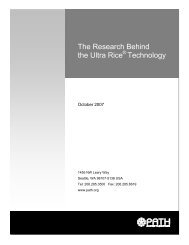Nepal Clean Home Delivery Kit: Evaluation of the Health Impact - Path
Nepal Clean Home Delivery Kit: Evaluation of the Health Impact - Path
Nepal Clean Home Delivery Kit: Evaluation of the Health Impact - Path
You also want an ePaper? Increase the reach of your titles
YUMPU automatically turns print PDFs into web optimized ePapers that Google loves.
Table 6 shows o<strong>the</strong>r birth practices possibly related to infection, such as substances put<br />
on <strong>the</strong> cord immediately after cutting or later, <strong>the</strong> covering put on <strong>the</strong> cord, and whe<strong>the</strong>r<br />
and when <strong>the</strong> attendant washes her hands. Most attendants put nothing on <strong>the</strong> cord (67%-<br />
76%). When <strong>the</strong>y did use something, trained attendants were more likely to use Dettol (a<br />
common antiseptic) while untrained attendants were more likely to use ash. Mustard oil<br />
was <strong>the</strong> most commonly applied substance later (55%-66%), followed by “nothing”<br />
(26%-38%). <strong>Kit</strong> non-users with trained attendants were <strong>the</strong> most likely to use herbal<br />
preparations later (11% vs. 2-4%). Among kit users, babies delivered by untrained<br />
attendants were <strong>the</strong> most likely to have dirty cloths on <strong>the</strong> cord stump at <strong>the</strong> time <strong>of</strong> <strong>the</strong><br />
interview (53%), while those with trained attendants were <strong>the</strong> least likely (42%). Babies<br />
delivered by trained and untrained kit non-users were equally likely to have a dirty cloth<br />
on <strong>the</strong> cord stump (47%). Among trained attendants slightly more kit users washed <strong>the</strong>ir<br />
hands before cutting <strong>the</strong> cord (96% vs. 90%), but among untrained attendants many more<br />
kit users than non-users washed <strong>the</strong>ir hands<br />
(91% vs. 76%; p< .001). Untrained attendants in both user and non-user cohorts were<br />
more likely than trained attendants to wash <strong>the</strong>ir hands only after cutting <strong>the</strong> cord.<br />
Table 6. Birth practices possibly related to infection, by cohort<br />
<strong>Kit</strong> User, <strong>Kit</strong> User, <strong>Kit</strong> Non-user, <strong>Kit</strong> Non-user,<br />
Trained Untrained Trained Untrained<br />
(Col %) (Col %) (Col %) (Col %)<br />
Put on cord Nothing 67.1 75.9 68.8 72.6<br />
just after Ash 5.7 12.1 9.9 14.2<br />
Dettol 11.2 6.5 9.9 1.8<br />
Mustard oil 1.9 2.5 3.5 5.0<br />
Antibiotic 2.1 0.5 2.0 0.5<br />
Herbal 2.1 1.0 0.5 3.4<br />
O<strong>the</strong>r 0.7 0.5 0.7 0.9<br />
Don’t know 9.0 1.0 4.7 1.6<br />
Put on cord later Nothing 32.1 26.4 29.0 37.9<br />
Mustard oil 57.6 66.2 56.2 55.3<br />
Herbal 4.3 3.0 10.9 1.8<br />
Antibiotic 3.8 2.5 3.0 1.4<br />
Don’t know 0.5 0 0.2 0.2<br />
O<strong>the</strong>r 1.7 1.8 0.7 3.4<br />
Cord covering <strong>Clean</strong> 56.3 45.7 48.7 49.0<br />
No cloth 1.5 1.8 4.3 3.8<br />
Dirty cloth 42.3 52.5 47.0 47.1<br />
Wash hands<br />
- at all Yes 98.3 90.6 95.4 75.9<br />
-before cord cut Yes 95.8 73.5 89.8 64.9<br />
-only after cord cut Yes 2.4 16.1 5.0 9.4<br />
13<br />
<strong>Nepal</strong> <strong>Delivery</strong> <strong>Kit</strong> <strong>Evaluation</strong> May 2000
















